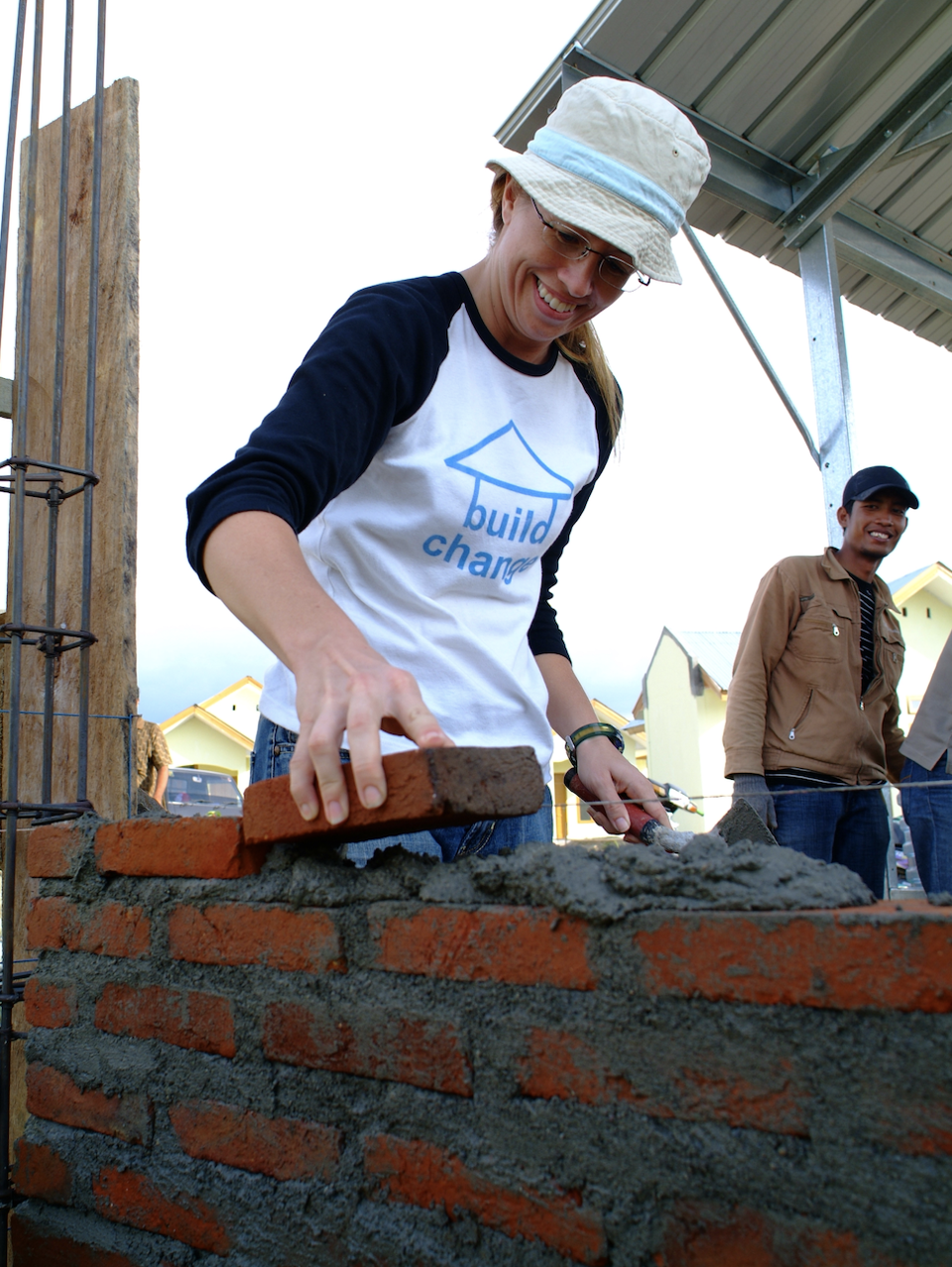
Elizabeth in Aceh, Indonesia, in the early days of Build Change – rebuilding after the tsunami.
Build Change
Elizabeth Hausler started Build Change 15 years ago to make disaster-resistant houses – reinforced structures that resist collapse in earthquakes or hurricanes – the new norm across the world. She and her team of civil engineers have responded to dozens of disasters, arriving after the immediate crisis clears to help local teams rebuild in new ways that prevent or mitigate future problems. We called Elizabeth to hear what challenges and opportunities she sees for transformative change in the wake of crises.
Elizabeth, you’ve lived and worked with many communities recovering from devastating loss due to earthquakes, hurricanes, and more. What is a common thread?
Human resilience. And the power of a person, a family, an entire community to recover and come back stronger. Many of the communities we’ve supported – in Nepal, Philippines, Colombia, Indonesia – are used to dealing with adversity. People are already living in an environment of resource scarcity, where life is not easy. Maybe they have daily challenges getting food, water, and help when they are sick. They are among the hardest-working and most resilient people I’ve met.
What does the path to recovery look like?
There is a natural sequence of recovery we’ve seen play out time and again after disasters – first, emergency medical care and search and rescue, then meeting basic needs for food and water. Economic recovery and getting back to work is usually next, followed by restoring social networks and getting kids back in school. Housing is often a lower priority. But even lower than that – and something I didn’t fully appreciate when we started Build Change– comes mental health recovery. It’s the most overlooked, the least valued.
But I’ve seen that change, particularly after the hurricanes in Puerto Rico in 2017. That’s where I felt like the community was finally putting mental health on the agenda at meetings, in discussions and working groups. People were planning for mental health recovery and funding it in a bigger way. It takes a mindset shift and preparation to mobilize resources for longer-term, especially when immediate needs are dire. And that applies not just to natural disasters, but any large-scale disaster – including the current pandemic.
As you’re watching the Covid crisis, what’s top of mind for you?
Gratitude that I have a decent house, with a functioning kitchen, running water, a toilet. I have space. But what’s the latest count? Some three billion people are on stay-at-home right now? Many are in substandard housing. They don’t have a place to wash their hands. Or space or opportunity to store food and stock up on supplies. Or there’s no separate room for a sick person to recover apart from the rest of the family. Sometimes population density is so high they cannot practice social distancing to keep themselves and their families safe.
No question, issues of substandard housing are exacerbating this pandemic, across much of the world. Will this shared experience we are having result in a movement toward improved living conditions, whether that’s better housing that has more space, or that’s going to hold up in the next disaster, or different homeless shelters, different arrangements for our senior centers?
How is Build Change adapting its work?
We’re advocating for economic recovery programs to invest in upgrading existing housing. What a great way to stimulate the economy, put money in the pockets of local workers, and create better living conditions at the same time. We’re getting ready to resume field work, adapting our Construction Worker Safety protocols to working in the new COVID-19 reality. And, we’re expanding our message. It started with earthquakes for us – how can we enable families to live in a house that doesn’t collapse in an earthquake. Now, the pandemic is raising water and sanitation aspects of housing. So, should we think of resilient housing in even broader terms: a functioning toilet and sink, enough space and light and air circulation, a roof that doesn’t leak, different interior configuration so there’s space for a sick person to recover without infecting the rest of the household.
What do you hope we learn from this moment?
Housing is a both a solution and a problem right now as billions are being asked to stay home. So how is the world’s view of housing, and the importance of decent, disaster-resilient housing, going to change? Will we prioritize better housing for everyone? Will we seize the moment immediately after the crisis, which, in our experience, is the ripest for transformative ideas to take root? And can we push ourselves even further to embrace, and plan for and fund, the concept of build better before?
Presidents Clinton and Bush introduced “build back better” after the devastating earthquake in Gujarat, India, in 2001. It’s time to universalize the message of build better before – adopting and resourcing prevention. Preventing the disaster, whether it is an earthquake, a hurricane, or a pandemic. It can apply to housing, hospitals, communities, nations, families. Build your financial resources, for those who can. Take care of your physical and mental health. Make your evacuation plan, or your financial contingency plan before you need to use them. Boost your immune system, right? Before the disaster is right upon us.
Elizabeth Hausler is a global expert on resilient building and post-disaster reconstruction. She holds a Ph.D. in civil engineering. She became fascinated by building much earlier – as a young person learning to lay bricks alongside her dad, a stonemason and builder in northeastern Illinois. You can read more about Elizabeth and Build Change here, and follow her on Twitter here and here. Elizabeth was elected as an Ashoka Fellow in 2009.
The article was originally posted at: %xml_tags[post_author]% %author_name% Source%post_title%
